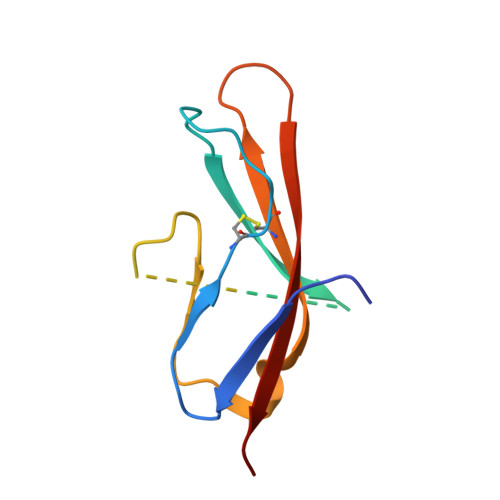Crystal Structure of the Extracellular Domain of the Human Dendritic Cell Surface Marker CD83.
Heilingloh, C.S., Klingl, S., Egerer-Sieber, C., Schmid, B., Weiler, S., Muhl-Zurbes, P., Hofmann, J., Stump, J.D., Sticht, H., Kummer, M., Steinkasserer, A., Muller, Y.A.(2017) J Mol Biol 429: 1227-1243
- PubMed: 28315353
- DOI: https://doi.org/10.1016/j.jmb.2017.03.009
- Primary Citation of Related Structures:
5MIX, 5MJ0, 5MJ1, 5MJ2 - PubMed Abstract:
CD83 is a type-I membrane protein and an efficient marker for identifying mature dendritic cells. Whereas membrane-bound, full-length CD83 co-stimulates the immune system, a soluble variant (sCD83), consisting of the extracellular domain only, displays strong immune-suppressive activities. Besides a prediction that sCD83 adopts a V-set Ig-like fold, however, little is known about the molecular architecture of CD83 and the mechanism by which CD83 exerts its function on dendritic cells and additional immune cells. Here, we report the crystal structure of human sCD83 up to a resolution of 1.7Å solved in three different crystal forms. Interestingly, β-strands C', C″, and D that are typical for V-set Ig-domains could not be traced in sCD83. Mass spectrometry analyses, limited proteolysis experiments, and bioinformatics studies show that the corresponding segment displays enhanced main-chain accessibility, extraordinary low sequence conservation, and a predicted high disorder propensity. Chimeric proteins with amino acid swaps in this segment show unaltered immune-suppressive activities in a TNF-α assay when compared to wild-type sCD83. This strongly indicates that this segment does not participate in the biological activity of CD83. The crystal structure of CD83 shows the recurrent formation of dimers and trimers in the various crystal forms and reveals strong structural similarities between sCD83 and B7 family members and CD48, a signaling lymphocyte activation molecule family member. This suggests that CD83 exerts its immunological activity by mixed homotypic and heterotypic interactions as typically observed for proteins present in the immunological synapse.
Organizational Affiliation:
Department of Immune Modulation, University Hospital Erlangen, Friedrich-Alexander-University Erlangen-Nürnberg, Hartmannstr. 14, D-91052 Erlangen, Germany.














